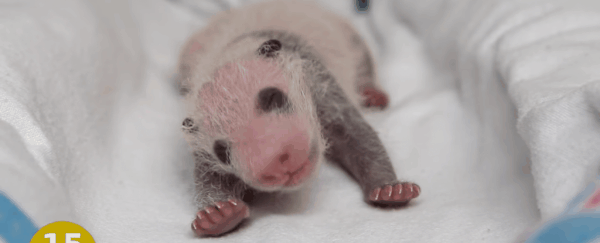When giant pandas are born, they are not giant. In fact, they are almost comically small compared to their mums. Now, new research on baby panda skeletons has revealed that in almost any other mammal, the developmental stage of panda cubs when they're born would be considered premature.
In short, giant panda bears are born at a stage of gestation that we'd think of as the beginning of the third trimester, if they were human babies.
At around 90 to 130 grams (3.2 to 4.6 ounces), newborn pandas are around the same size as a domestic cat's kittens - not at all what you'd expect from a bear that tips the scales at 120 kilograms (220 pounds).
The birth weight of the giant panda (Ailuropoda melanoleuca) has long baffled biologists. The bears are born pink, squeaking and blind, still looking like a foetus, and extremely small - the mass ratio of the cub to mother hovers around 1:900. That's the lowest birth weight ratio of all placental mammals, since most mammals are closer to 1:26.
In fact, all bears (family Ursidae) have unusually small cubs, but the giant pandas are particularly pronounced. This phenomenon is normally only seen in monotremes and marsupials, which give birth to positively lilliputian babies - and then nurse them intensively, usually in a maternal pouch, until they have finished baking.
But pandas and other bears don't have pouches. So biologists Peishu Li and Kathleen Smith of Duke University decided to study the skeletons of giant panda cubs to find out what gives.
Captive breeding of the ecologically vulnerable giant panda has been a tricky thing to master, and any cubs resulting from these programs are given the best care possible, so the skeletal remains of panda cubs are not easily obtained.
But, in the 1980s, five cubs were born to giant pandas Ling-Ling and Hsing-Hsing at the Smithsonian's National Zoo that, sadly, did not survive long after birth. Their skeletons were preserved, so Li and Smith were able to take micro-CT scans of two of them.
They also took scans of some other mammals' newborns - grizzly bears (Ursus arctos), sloth bears (Melursus ursinus), polar bears (U. maritimus), a red panda (Ailurus fulgens), a coati (Nasua narica), an African wild dog (Lycaon pictus), an arctic fox (Vulpes lagopus) and two domestic dogs (Canis familiaris), one of which was foetal.
They created 3D models of all the skeletons, and carefully studied them to see how developed they were - the level of ossification, or bone growth; whether the teeth had started to form or erupt; and the fusion of the plates of the skull.
One hypothesis about the low birth weight of bears involves hibernation; the idea goes that if the pregnancy overlaps with hibernation, that period of fasting could result in an earlier birth when the mother's internal reserves grow low.
Not all bears hibernate - giant pandas don't, for instance - but, scientists have argued that over the course of evolution, low birth weight could have become a feature of bears in general.
But in this study, when the biologists examined and compared all the skeletons, they found that, overall, the skeletons of newborn bears were just as developed as the skeletons of the other newborn animals. This would suggest that bear cubs are born full term.
With one exception. The giant panda cubs. Their bones resembled those of the puppy foetus, delivered several weeks before it was due, at around 70 percent of its gestation period.
"That would be like a 28-week human fetus," Smith said. (The human gestation period is 40 weeks.)
The giant panda's gestation period is 97 to 161 days, which seems like a long time, considering how tiny the cubs are. Previous studies have shown that's because of delayed implantation, in which the embryo floats around in the womb for a few months before attaching to the wall of the uterus; it will only start developing after this attachment.
This is common in bears, and it may have something to do with food availability. But in pandas, the period of gestation after attachment is much shorter than other bears. They follow the same development trajectory as other mammals, but they pop out before they're done.
"They're basically undercooked," Li said.
The reason for this? Well, we still don't know. What we do know is that the size of adult bears has increased in the last 20 million years; perhaps while the bears grew, the birth weight of their cubs did not.
"Given its close phylogenetic affinity with other ursine bears and adaptations to an herbivorous diet like the giant panda, the cave bear may be a promising candidate to further shed light upon the relationship between phylogeny, herbivory and reproductive physiology among Ursidae," the researchers conclude in their paper.
The research has been published in the Journal of Anatomy.
